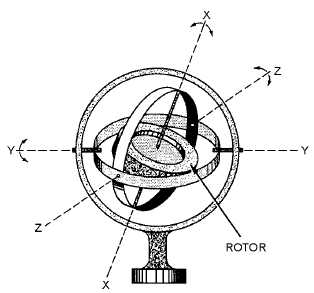3-2
Figure 3-1.—Gyro model, universally mounted.
BASIC PROPERTIES OF GYROSCOPES
Gyroscopes have two basic properties: rigidity and precession. Those properties are defined as
follows:
1. RIGIDITY — The axis of rotation (spin axis) of the gyro wheel tends to remain in a fixed
direction in space if no force is applied to it.
2. PRECESSION — The axis of rotation has a tendency to turn at a right angle to the direction of an
applied force.
The idea of maintaining a fixed direction in space is simple to illustrate. When any object is spinning
rapidly, it tends to keep its axis pointed always in the same direction. A toy top is a good example. As
long as the top is spinning fast, it stays balanced on its point. Because of this gyro action, the spinning top
resists the tendency of gravity to change the direction of its axis. You can think of many more examples.
A bicycle is easier to balance at high speed than when it is barely moving. At high speed, the bicycle
wheels act as gyros, and tend to keep their axes (axles) parallel to the ground.
Note that it is easy to move the gyro as long as you keep the axis POINTING in the SAME
DIRECTION. The gyro resists only those forces that tend to change the direction of its axis. In a bicycle,
since the axis of rotation (the wheel's axles) is horizontal, the wheels win resist any force that tends to tilt
or turn them to the right or left.
If you can obtain a gyroscope top, you can do some instructive experiments with it. Hold the gyro
top with its axis vertical as shown in figure 3-2 and start it spinning. As long as it is spinning fast, it will
stay balanced. You can balance it on a string or on the point of your finger; the axis will stay vertical as
long as the top is spinning fast. As we mentioned before, this ability of a gyro to keep its axis fixed in
space is called RIGIDITY.

